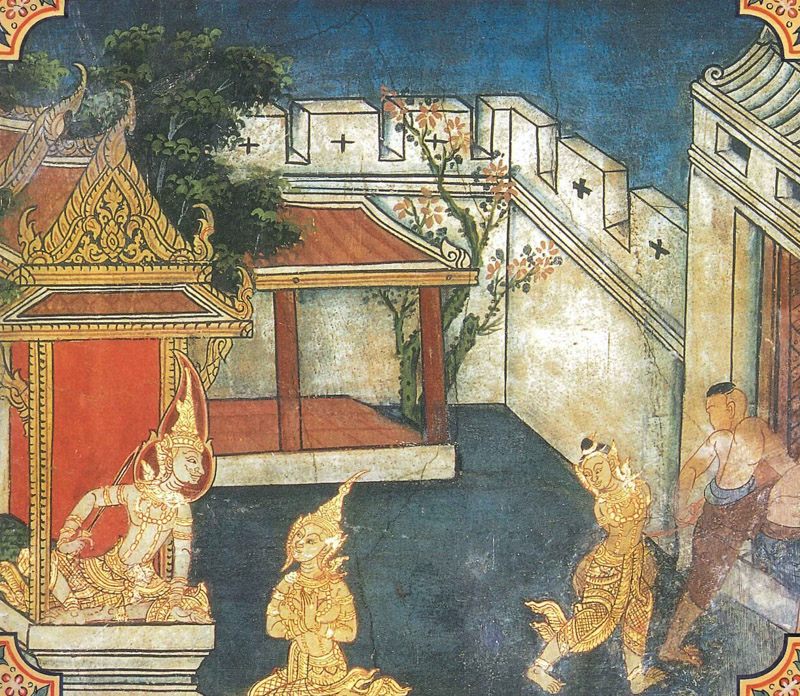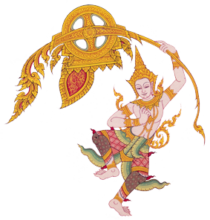
The Bodhisatta was once a prince, righteous and beloved by all. When his mother died, his father took a new queen. Soon after, the king traveled to put down a rebellion in a border region. Just before the king returned to the palace, the queen tried to seduce the Bodhisatta, but he refused her advances, even when she threatened to have the king execute him.
Before the king came to see her in her bedchamber, the queen scratched her skin and feigned illness. When the king asked what was wrong, she lied, saying the Bodhisatta had demanded sex and beat her when she refused. The king was enraged and had his son beaten, bound, and brought before him. The Bodhisatta protested his innocence and asked why his father would believe a woman. But the king did not feel an investigation was necessary and ordered him immediately thrown over the thieves’ cliff. The entire city was distraught. Men and women wept and pulled out their hair, and nobles and warrior chiefs rebuked the king, reminding him that it was his duty to act wisely and cautiously. But the king was not moved, and the Bodhisatta was thrown down.
The spirit that lived in the hill caught the Bodhisatta before he hit the ground and took him to the home of a naga king, where he was shown great honor. He stayed there for a year before returning to the realm of man to live as an ascetic in the Himalayas. Then one day a forester from the city saw the Bodhisatta, and after spending some days with him, he returned home and told the king that his son was alive. The king, his anger having faded with time, set out to meet him.
The Bodhisatta welcomed him, and they discussed what had happened, then the king invited him to return and become king. But the Bodhisatta said he was happy in his simple religious life and had no desire to rule. He criticized his father’s behavior and urged him, from this point forward, to stop doing evil and start following the ten royal virtues. The king, now fully recognizing his son’s righteousness, left in tears and asked his advisors who had caused him to try to kill his own son. They reminded him that it was his queen, so when he returned to the palace, he had her thrown over the cliff, and from that point on he ruled in righteousness.
In the Lifetime of the Buddha
As the Buddha’s fame grew and his disciples multiplied, other religious teachers lost most of their followers. Upset over this, some heretics enlisted a beautiful woman named Cinca-Manavika to destroy the Buddha’s reputation so they would receive more praise and alms. The scheme she devised began with her sleeping in the countryside near the Buddha’s monastery, then walking toward the city early in the morning so the people she passed would believe she had actually been spending the night there. After four months of this, she started wrapping cloth around her stomach and announced that she was pregnant with the Buddha’s child. Some people believed her.
As the ninth month approached, Cinca-Manavika added pieces of wood to her belly bundle and beat her hands and feet with the jawbone of an ox to induce swelling. She then walked up to the Buddha during a sermon and cursed him for having a sweet voice but bad behavior. As she publicly denounced him for denying being with her and for not providing a chamber to stay in until she gave birth, the throne of Indra, king of the gods, became warm and he divined what was happening. He and four other gods came to earth in the form of mice and gnawed through the ropes that held Cinca-Manavika’s fake stomach up: The wood fell down, severing her toes and revealing her deceit. As she fled the Buddha’s angry followers, the ground split open and the flames of hell dragged her down. The religious leaders who had helped her lost what little support they still had.
The wicked queen was an earlier birth of Cinca-Manavika, and after her lie was exposed, the Buddha told this story so his disciples knew this was not the first time she had tried and failed to destroy him.
The king was an earlier birth of Devadatta, a disciple of the Buddha who became his nemesis and tried to kill him three times, and the spirit who rescued him and the naga king who helped him were earlier births of Sariputta and Ananda, two of the Buddha’s top disciples.
